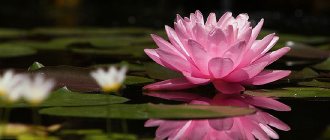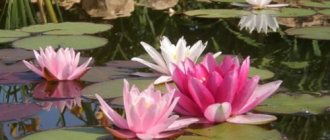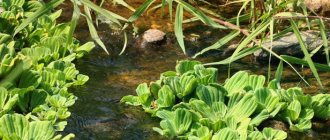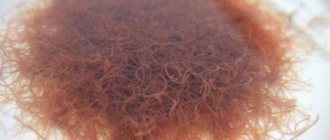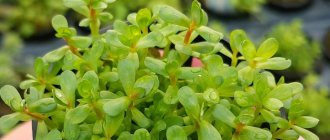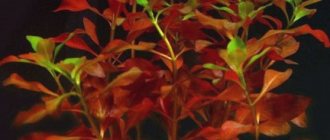Nympheas (water lilies, water lilies) are an unusual decoration for natural or artificial reservoirs, which is gaining popularity in landscape design. Caring for nymphs in a pond is not difficult, but you need to take into account the characteristics of the plant. If you create suitable conditions for them, they annually delight you with large, symmetrical flowers of any shade.
Question number 2: What size pond is needed to plant a water lily?
It is believed that one adult water lily plant requires approximately 1 m2 of area. In fact, as a rule, it is more. The depth of the pond should be at least 40 cm and can reach up to 1 m. So, we believe that a small dwarf water lily, such as those sold with the prefix to the name Pygmaea, can be grown in an ordinary flowerpot with a diameter of half a meter - a meter and a depth of up to half a meter (keep in mind that the water in such containers it evaporates quickly and, as a rule, is below the level of the sides). For medium-sized varieties, which are most stable in the middle zone and are most often sold in specialized stores, it is best to prepare a pond with a depth of 60-80 cm and a diameter of at least one and a half, for three plants - already about 3 m.
If the pond is small, then a classic shape would look better - a circle or square, ideally with classic stone or wooden sides. If it is large, it is better to make it in a natural style with a winding bank and coastal plants.
Nymphea - planting water lilies
If you decide to purchase a beautiful nymphea in a store where it is sold in a special container, follow the following recommendations: • After purchasing, the plant should be planted immediately, without waiting for it to dry out. As a rule, water lilies are sold in containers filled with water or sprinkled with perlite. • When choosing a plant, pay attention to the number of dormant buds. Take a closer look to make sure there are no signs of rot. You should also carefully examine the rhizome. After purchasing, it is advisable to rinse the root with running water to prevent possible infections or pests from entering the pond.
Question number 4: What varieties of water lilies are best to buy first?
All varieties of lilies are divided into 2 groups according to origin and 4 according to size. By origin: tropical (Tropical, T), we discard these immediately if we are not going to grow them in a greenhouse, and winter-hardy - this is just our option.
By size they are divided into dwarf, small, medium and large. The division is quite arbitrary, theoretically, dwarf varieties grow at a depth of about 25 cm, and large ones require a depth of 50-100 cm. In fact, they all grow well at a depth of 40 to 80 (100 cm). But still, it is better to take into account size and depth and, if possible, correlate.
Dwarf nymphs
They are not resistant enough to grow in large bodies of water; they are best planted in small warm ponds or containers. Most often sold as nymphs are Pygmaea, i.e. Pygmaea Helvola (light yellow flowers, leaves with brown spots), Pygmaea Alba (white flowers), Pygmaea Rubra (red flowers).
Read more about water containers>>>>
Small and medium nymphs
These varieties are most suitable for cultivation in the Moscow region and central Russia. The list of varieties is quite extensive; they can be roughly divided by color:
— white nymphs: Gladstoniana, Laydekeri Alba, Perry's Double White, White Sensation;
— yellow and orange nymphs: Carolina Sunset, Gold Medal, Sulphurea, Paul Hariot, Yellow Princess, Yellow Sensation;
— pink and red nymphs: Burgundy Princes, Fabiola, Firecrest, Laydekeri Purpulata, Lily Pons, Peter Slocum, Red Queen, Rosennymphe, Ruby Red;
— dark red nymphs: Almost Black, Black Princess.
Nymphea Black Princess
Nymphea White Sensation
Characteristic features of the nymph
Nymphea or water lily is a well-known herbaceous perennial plant, distributed in different parts of the world. There are approximately 50 species of this perennial.
Nymphea captivates with its beauty. The leaves of this plant are distinguished by their unusual round or heart-shaped shape, and the large star-shaped or cup-shaped flowers are noticeable from afar due to their variegated color. There are snow-white, cream, yellow, orange, red and even blue simple or double flowers!
The root system of the nymphea is very large, but the roots themselves, although they seem strong, are actually delicate. To avoid damaging them, it is necessary to add small pebbles or sand to the soil.
Nymphs are also amazing because they grow in stagnant or slowly flowing waters. Some types of water lilies bloom during the day, while others bloom at night. Often the blossoming flowers emit a delicate aroma.
Nymphea loves the sun and warmth. But this plant is also picky about the soil - the soil must be nutritious, with a high clay content.
All nymphs are divided into two large groups - winter-hardy and tropical. Winter-hardy nymphs feel good in almost any climate and are distinguished by lush and long-lasting flowering throughout the summer. But tropical nymphs are very sensitive and delicate, they should not be grown in cold climates.
Nymphs are also divided according to their size - they are large, medium, small and dwarf. But it is not easy to find any pure species, because recently hybrids that combine the best characteristics of different varieties have become increasingly popular.
The great advantage of hybrid varieties of nymphs is that they can be grown not only in open reservoirs, but also in compact containers indoors. And although nymphs originated in Africa, today most species are well adapted to difficult climatic conditions.
The fruits of the nymphea are berry-shaped and ripen under water, which is also another interesting feature of this plant.
Nymphs are successfully grown not only in large reservoirs or small containers, but also in aquariums. But no matter where this perennial grows, it requires good lighting, warmth, soil containing clay and frequent fertilizing.
Question number 6: How to plant water lilies correctly?
Of course, theoretically, there are two ways to plant water lilies: directly in the ground or in a container. However, if you do not have a 10-meter landscaped pond on your property, then planting in the ground will not suit you. Nowadays planting in a container-basket is almost universally used. This gives a number of advantages over planting in the ground: the plant can be moved from place to place, the plant is easy to divide and preserve in winter. Eventually, when it becomes necessary to clean the pond, the water lily can be removed from the water.
Water lilies are planted in a container-basket with loamy soil mixed with bone meal (basic composition: clay with a small amount of garden soil and special fertilizer for aquatic plants, sand and pebbles on top).
Read more about planting aquatic plants in our material>>>>
Nymphs do not divide often, once every 3-5 years. The larger the plant, the more flowers it will produce per season. When dividing, do not be afraid to cut off old roots; nymphs tolerate this easily.
Caring for nymphs in a pond
Water lilies are unpretentious plants that grow easily, quickly fill the available space and quickly begin to bloom after planting. However, it is necessary to create suitable conditions for them, especially in artificial reservoirs.
To follow the rules for caring for nymphs in a pond, several factors should be taken into account:
- purity of water - water lilies do not grow in polluted waters;
- sufficient nutrients for growth and flowering;
- suitable soil and container for planting;
- competent preparation for wintering, taking into account the structural features of the pond.
Planting and caring for a nymph is not a difficult task. In nature, these plants grow deeper into the ground with their rhizomes, but at home they are easier to grow in pots. The container should be wide enough, since the roots of the water lily grow in a horizontal direction. However, you should not choose pots that are too large so that they can be lifted and rearranged or taken to a warm room for the winter.
Preparation of the reservoir
For nymphs, a natural or artificial reservoir with an earthen or concrete bottom is suitable - these features will determine the growing technology. The main care for a pond is to clean it in the spring. Organic debris must be removed from the water: last year’s fallen leaves, tree branches and other impurities. In clean water, flowers grow quickly and fill the available space.
Planting water lilies
The success of growing and ease of caring for nymphs in a pond depends on their proper planting. At home, it is easier to place plants in containers to control their numbers and, if necessary, move them in a pond. There are special containers for water lilies on sale, but any pots with drainage holes will do. Large varieties will need a container of at least 10–12 liters, while miniature varieties will need a small container. The pot can be low, but wide enough for rapid growth of the rhizome.
The container is filled with a mixture in which the water lilies will quickly grow and bloom. It includes three components in equal proportions:
- high-quality wet clay, without lumps and sand;
- ordinary soil for garden and ornamental plants;
- organic fertilizer - you can use humus or manure.
A layer of mixture for growing nymphs is laid out at the bottom of the container. The rhizome of the plant should be positioned horizontally so that the roots point downwards. The edge, which is located on the side opposite to the growing bud, should be near the wall of the pot so that the roots can grow freely. A dense layer of earthen mixture is laid on top. It is recommended to add a layer of pebbles or small stones on the surface. They will not allow the soil to be washed out by water, and will also protect the roots from being torn by fish if they are in the reservoir.
Containers with water lilies are placed at the bottom of the reservoir. The optimal planting depth differs for different varieties, but on average is up to 60 cm. If you place the pot deep, the leaves and flowers will be able to appear on the surface, but the roots will not be warmed by the sun's rays. Placing the container shallow will cause the leaves to rise above the water too quickly. When choosing a nymph variety, it is important to consider the size of the adult plant and its need for water depth.
To grow water lilies, you should choose a container with two handles. With them it is more convenient to lift the pot to the surface and move it in the pond.
Caring for mature plants
Fertilizing water lilies will promote their rapid growth and abundant flowering. They can be added only once a year, during spring cleaning of the pond, replanting plants, or planting them in a pond after wintering. Bone meal is considered an effective feed for nymphs. So that it is not quickly washed out with water and continues to act for a long time, a pinch of flour can be rolled into a clay ball and placed in a container. There are also crystalline fertilizers on sale that go a little deeper into the soil.
Caring for adult plants also includes timely replanting and monitoring the propagation of water lilies.
If in the spring it is discovered that the rhizome is crowded in the container, it is divided into parts. It is also necessary to thin out the pond from leaves so that they do not cover the surface of the water too thickly. If the reservoir is less than a third full, the flowers grow as large as possible.
Reproduction of water lilies
The easiest way to propagate water lilies is by dividing the rhizomes. It can be used at home to fill a large pond with flowers. The nymphea has a strong horizontal rhizome, from which small lateral roots extend. Every year it can be divided and new plants obtained. The optimal time for flower propagation is early spring, before planting water lilies in ponds. However, for frost-resistant varieties that overwinter directly in the pond, the procedure can be carried out after the last varieties have flowered - in the spring it is difficult due to the low water temperature.
To propagate a water lily by dividing the rhizome, just follow a few simple steps:
- untangle the stems and lift the pot with the plant to the surface;
- Use a sharp knife to separate a small section of the rhizome on which the bud is located;
- place a piece of rhizome in a previously prepared pot with a mixture for water lilies;
- Immerse the container in water and wait for the first floating leaves to appear above the surface of the water.
There is also a way to grow nymphs from seeds. They can be purchased at the store or assembled yourself. In winter, they should be kept at a low temperature, after which it is gradually increased. In the spring, planting material is deepened into the soil and immersed in water to a shallow depth. Water lilies grow slowly, and floating leaves with flowers appear only the next year after planting. This method is rarely used at home, but is suitable for breeding new varieties.
When breeding nymphs, it is enough to fill the pond with flowers no more than a third. Lack of space affects the size of flowers - their diameter can decrease to 3-5 cm.
Caring for nymphs in winter
There are frost-resistant and heat-loving varieties of nymphs. If the latter overwinter only in a warm room, then the method of keeping the former depends on the type and depth of the pond.
There are several ways to care for water lilies during the cold season:
- The first option is a frost-resistant variety of water lily that grows in a deep reservoir (60 cm or more) with an earthen bottom. It is the simplest, since the pond does not freeze to the bottom even during frosts. Water lilies can remain outside over the winter.
- The second option is a shallow pond with earthen soil at the bottom. For wintering, you can dig a hole and place the rhizome of a water lily there to protect it from frost.
- The third option, in which nymphs are necessarily grown in containers and moved indoors for the winter, is a shallow pond with a concreted bottom. It is impossible to dig it up to protect its roots from low temperatures, so it is necessary to prepare in advance the conditions for overwintering the plant indoors.
There is a way to preserve a nymph in winter if the pond freezes during the cold season. The plant should be removed from the soil and the stems and leaves should be cut off. The rhizome is placed in a substrate that retains moisture well - moss or perlite will do. It can be stored in winter in a regular plastic bag or any container in the refrigerator. The water lily tolerates the cold season well outside the pot in which it grows, provided that the substrate is maintained at constant moisture.
The water lily will become the main decoration of a large lake or miniature home pond. There are a huge number of varieties of water lilies on sale, so it’s easy to choose the right option for a pond of a certain size and depth. The plant pleases with its unusual flowering throughout the summer with minimal care, so it is suitable even for beginners.
Question number 7: How to care for water lilies in summer?
If nymphs do not need watering, then they still need to be fed. It is necessary to apply fertilizing directly to the soil in the spring, before installing the container in the pond. But be careful with feeding for nymphs; if you feed them in excess, you can cause increased blooming of the water.
In addition to feeding, it is necessary to monitor the appearance of the plant. Trim dead leaves and remove debris that gets caught in the rosette of leaves.
Preparing the plant for wintering
The water lily cannot overwinter in shallow reservoirs outside; this is true for all cases when freezing reaches the bottom.
Let's figure out a little how to prepare a nymph for winter. The best place for wintering may be the basement. Storing nymphs in the basement: simply take out the container in which the rhizomes are located and transfer it to the basement or other dark, cool place, but inaccessible to frost. If you are sure that your pond will not freeze to the bottom, then the water lilies can be left to overwinter in place. This applies to reservoirs with a depth of 0.5 m.
As you understand, water lilies are quite easy to grow at home. Create favorable conditions for them and admire the beautiful flowers.
Question number 8: How to preserve water lilies in winter?
Perhaps this is the most critical stage in the life of a plant. First of all, wintering depends on your pond and the water lily itself. If the pond is deep and you grow our Russian white water lily in it, brought from a nearby pond, then leave it there for the winter and forget about it until spring. Provided that the pond is deeper than the freezing point.
If your pond is shallow, and the water lily is pink, yellow or red, clearly a varietal one, you will either have to move the container with the plant to a deeper pond (the depth from the surface of the water to the bud is at least 50 cm, but many have lost their plants at a depth of 80 cm ), or to the basement.
In the second case, the ideal storage temperature is about +5 °C. And, of course, the roots should not be allowed to dry out: place the containers with the rhizomes in a basin or bucket of water. Method from gardeners: If you don’t have a basement and the pond is about 50 cm deep, try keeping your plants like this. Place several long boards on top of the pond and lay Lutrasil 60 on them in two layers. Leave your nymphs in the pond under this cover.
What does a nymphea aquatic plant look like?
A perennial herbaceous aquatic plant - nymphea. To better understand what it is, it is worth considering the characteristics:
- The stems of the plant are rhizomes, horizontally immersed in the ground, but they can also take the form of tubers.
- On the surface of the water there are surface leaves that have a rounded plate with a pronounced notch. They are dense and covered with a waxy coating that prevents them from getting wet. The size of the plates differs depending on the type. As for the underwater foliage, it is different and is broadly lanceolate, filmy and rolled into a cap.
- Flowering of nymphs in the northern territories begins in June, and in the south - in May. The buds open in the morning and close after sunset. They can be painted in different shades, so it all depends on the variety. Flowering lasts up to four days. The flower has a symmetrical shape and its diameter varies from 3 to 30 cm. The surface can be semi-double or double. In the center of the bud there are numerous yellow or orange stamens.
Question number 9: Is there anyone who wants to eat the plant? What enemies does the water lily have?
Everyone has enemies, but the water lily, fortunately, has few of them. Pond snails and aphids love to eat juicy greens. It is better to remove them manually. This works especially well with snails. If there is nothing else alive in the pond besides nymphs, especially fish, then you can use insecticides on the leaves. But if possible, it is better to refrain from using chemicals.
There are special products for treating fish that are added to the water. They are also suitable for treating water with nymphs.
Pests and diseases of nymphs
Nymphs almost never get sick.
A possible difficulty encountered in growing nymphs in a decorative pond is root rotting. The cause of rotting may be a fungal infection that infected the root upon purchase, as well as the appearance of toxic substances in the reservoir. Prevention of the disease is the purchase of a healthy plant and timely thinning of the nymphs. The main enemy of the queen of reservoirs is aphids. The difficulty in killing aphids is that the pond cannot be treated with pesticides. Aphids can only be washed off from water lily leaves mechanically. The pitcher leaf beetle is a small bug with a brown color. It harms water lilies by laying eggs on the leaves of the plant. The hatched larvae feed on the leaves, gnawing holes in them. Leaf beetle larvae are collected manually, and damaged leaves are removed. Leaf spot is a disease characterized by the appearance of black round spots on the leaf blade of water lilies. After some time, the spots increase in size, rot and through holes form in the leaves. If this disease is present, the leaves should be removed. [/td]
Methods for propagating nymphs
The easiest way to get another water lily seedling is to divide the rhizome into 2 or more parts. The propagation procedure is best carried out in the spring after wintering or during the next transplant. To do this, you need to remove the rhizome from the container and divide it into several parts so that each has 2-3 buds and several thin roots. The seedlings need to be placed in separate containers and placed in a pond in shallow water, and as they grow, transferred to the desired depth.
Source
Varieties and types of water lilies
White water lily is a large variety. It will grow in Africa and Eurasia in quiet river backwaters. It has large dark green leaf blades and large white inflorescences with yellow anthers that have a delicate aroma.
Snow White water lily - the plant belongs to small varieties. It grows in reservoirs in the middle part of our country. The leaf blades have a dark green tint, a round shape with a part dissected at the base. The inflorescences are small, white in color with a pleasant aroma.
Yellow Water Lily - nymphea is one of the smallest and easiest varieties to grow. It has round leaf plates of a green hue with red streaks. The inflorescences are small, pale yellow with a light aroma.
Nymphea Tiger Red - the plant belongs to small varieties. The culture has large red leaf blades with black specks. The inflorescences are small, white, and have a pleasant aroma. Flowering time occurs in the first half of summer and ends in early autumn. This variety can be grown in both ponds and aquariums.
Pink water lily - the plant belongs to small varieties. The water lily has large olive green leaves with a patterned edge. The inflorescences are bright pink with a yellow center, resembling a lotus in appearance. The flowers have a persistent pleasant aroma.
Water lily Victoria Regia
Refers to large varieties. The leaf blades are large, resembling a plate with raised edges, and there are more veins on the inside of the leaf. The inflorescences are large, snow-white with a yellow anther and a pleasant aroma. Flowering time occurs in mid-summer and ends in early autumn.
Nymphea Rubra - the plant belongs to the middle varieties. The leaves are large, flat, round and green in color with a dissected edge. The inflorescences are medium-sized, red-crimson in color with a yellow center. The flowers have a pleasant aroma. The flowering time of nymphs lasts from mid-summer to early autumn.
Water lily tetrahedral - the plant belongs to small varieties of water lilies. Grows in Siberia. The leaf blades are small, round and dark green. The inflorescences are small, lilac-pink in color with a yellow center and a pleasant aroma. The water lily blooms from mid-summer.
Nymphea Mikrantha - has both above-water and underwater leaf plates. The surface leaves are large and green in color. Those that grow underwater are smaller and have a red-green hue with dark specks. The inflorescences are white, star-shaped with a pleasant aroma. Flowering time occurs in July and ends in September.
Nymphea Rudge - refers to small varieties of nymphs. The leaf blades are large, round, green-pink in color. The inflorescences are small, pleasantly smelling white with a yellow center. The water lily blooms in mid-summer.
Nymphea Stellata
The plant differs from other varieties in its large, round, reddish leaf blades. The inflorescences are large, star-shaped. They can have red, white, blue and gradient shades.
Nymphea Vanvisa - this variety of water lilies was bred in Thailand. The leaf blades are round, large, dark green with red streaks. The inflorescences are large, located high above the water. The petals have a pink tint with light stripes and a pleasant aroma. The flowering time of the water lily occurs in mid-summer and ends in autumn.
Marsh Water Lily - the plant grows in the backwaters of rivers with standing water. The leaf blades are large, dark green with a dissected edge at the petiole. The inflorescences are medium-sized, white with a yellow center and a pleasant aroma. The water lily blooms in late June - early July.
Nymphea Black Princess is a frost-resistant, unpretentious variety. The leaves of the plant are round, flat, dark green or burgundy. The inflorescences are large, velvety dark cherry in color with a yellow anther. The flowering time of the water lily occurs in July and ends in early autumn.
Nymphea Viviparous - the plant belongs to small varieties. The leaf blades are oval with a slightly pointed end. They have a light green tint with dark and burgundy specks. The plant has leaf blades both above and below the water. The inflorescences are small, white in color. This variety of nymphs can be grown both in a pond and in an aquarium.
Nymphea Attraction
The culture belongs to large varieties. The leaf blades are round, olive or burgundy in color. In young nymphs the inflorescences are pale pink, while in adult plants they are crimson with white stripes on the petals. This variety was bred in 1910.
Mexican water lily - the plant belongs to the middle varieties. The water lily grows in Texas. It has large flat leaf blades and small, oval-shaped leaves folded into a cup shape. The flowers are medium-sized, yellow in color, located above the water. The water lily blooms in mid-summer and early autumn.
Egyptian water lily - refers to small varieties of water lilies. The leaf blades are small, bright green with dark specks. They grow both above and below water. Water lily inflorescences are small, white with a yellow center.
Water lily small-flowered - in the wild the plant grows in West Africa. The leaf blades are round, small, olive in color with dark and red streaks. The inflorescences are also large, white with pointed petals. The plant blooms from mid-June to early September.
Blue water lily is an amphibious perennial from the lotus family. It has leathery, dark green leaves on the outside and burgundy on the inside. The inflorescences are medium-sized, blue or pale purple in color with a pleasant aroma. The water lily blooms during the day, in the evening the bud closes and sinks under the water.
Problems when growing nymphs
Gardeners who grow nymphs may have some problems.
Most often you encounter the following:
- Lack of flowering - a water lily may not bloom for two reasons. Due to improperly selected soil and low temperatures or the container being too deep in the water. After eliminating these shortcomings, the plant will definitely bloom.
- Holey leaf plates - the appearance of holes in the leaf plates is evidence of an attack by the water lily booger. To destroy this pest, the reeds that grow in the pond along with the nymph should be cut down, but in general, it is better not to plant them in the same pond with water lilies.
- Green water in a pond with water lilies - this problem is caused by duckweed blooming and is not dangerous for the water lily. However, to clear the water of algae, you can filter it or add special preparations that are harmless to the plant, which will completely clear the pond of blooming algae.
If you follow all the rules regarding water lily care, the problems described above will not arise.
Water lilies signs and superstitions
It is believed that the plant is a talisman against everything bad. This flower is suitable only for people with a pure heart. In ancient times, it was believed that only a good person could pick an inflorescence; a bad person, with negative thoughts and intentions, would be drowned by mermaids who protect the grass. It is for this reason that signs appeared regarding the fact that it is impossible to tear a nymph and bring it into the house.
Among the Slavs, this flower was considered a powerful amulet. Those who had to travel frequently took the plant with them as an amulet. It was also believed that the flower could awaken talents in a person and cure any disease.
From ancient times to the present day there has been a sign that a water lily cannot be given as a gift, as it will bring misfortune. In fact, it's exactly the opposite. A bouquet of nymphs given to your other half will allow you to harmonize your relationship and bring positive energy into your home.
